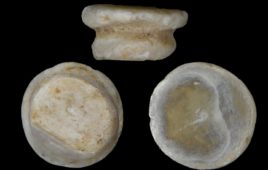This is an artist’s concept of excess left-hand aspartic acid created in asteroids and delivered to Earth via meteorite impacts. The line at the bottom is a chromatogram showing that left-hand aspartic acid (tall peak in the center, with diagram of left-hand aspartic acid molecule on top) was four times more abundant in the meteorite sample than right-hand aspartic acid (smaller peak to the left, with right-handed aspartic acid molecule on top). Credit: NASA/Hrybyk-Keith, Mary P. |
Researchers
analyzing meteorite fragments that fell on a frozen lake in Canada have
developed an explanation for the origin of life’s handedness—why living
things only use molecules with specific orientations. The work also
gave the strongest evidence to date that liquid water inside an asteroid
leads to a strong preference of left-handed over right-handed forms of
some common protein amino acids in meteorites. The result makes the
search for extraterrestrial life more challenging.
“Our
analysis of the amino acids in meteorite fragments from Tagish Lake
gave us one possible explanation for why all known life uses only
left-handed versions of amino acids to build proteins,” said Dr. Daniel
Glavin of NASA’s Goddard Space Flight Center in Greenbelt, Md. Glavin is
lead author of a paper on this research to be published in the journal
Meteoritics and Planetary Science.
In
January, 2000, a large meteoroid exploded in the atmosphere over
northern British Columbia, Canada, and rained fragments across the
frozen surface of Tagish Lake. Because many people witnessed the
fireball, pieces were collected within days and kept preserved in their
frozen state. This ensured that there was very little contamination from
terrestrial life. “The Tagish Lake meteorite continues to reveal more
secrets about the early Solar System the more we investigate it,” said
Dr. Christopher Herd of the University of Alberta, Edmonton, Canada, a
co-author on the paper who provided samples of the Tagish Lake meteorite
for the team to analyze. “This latest study gives us a glimpse into the
role that water percolating through asteroids must have played in
making the left-handed amino acids that are so characteristic of all
life on Earth.”
Proteins
are the workhorse molecules of life, used in everything from structures
like hair to enzymes, the catalysts that speed up or regulate chemical
reactions. Just as the 26 letters of the alphabet are arranged in
limitless combinations to make words, life uses 20 different amino acids
in a huge variety of arrangements to build millions of different
proteins. Amino acid molecules can be built in two ways that are mirror
images of each other, like your hands. Although life based on
right-handed amino acids would presumably work fine, they can’t be
mixed. “Synthetic proteins created using a mix of left- and right-handed
amino acids just don’t work,” says Dr. Jason Dworkin of NASA Goddard,
co-author of the study and head of the Goddard Astrobiology Analytical Laboratory, where the analysis was performed.
Since
life can’t function with a mix of left- and right-handed amino acids,
researchers want to know how life—at least, life on Earth—got set up
with the left-handed ones. “The handedness observed in biological
molecules—left-handed amino acids and right-handed sugars—is a property
important for molecular recognition processes and is thought to be a
prerequisite for life,” said Dworkin. All ordinary methods of
synthetically creating amino acids result in equal mixtures of left- and
right-handed amino acids. Therefore, how the nearly exclusive
production of one hand of such molecules arose from what were presumably
equal mixtures of left and right molecules in a prebiotic world has
been an area of intensive research.
The
team ground up samples of the Tagish Lake meteorites, mixed them into a
hot-water solution, then separated and identified the molecules in them
using a liquid chromatograph mass spectrometer. “We discovered that the
samples had about four times as many left-handed versions of aspartic
acid as the opposite hand,” says Glavin. Aspartic acid is an amino acid
used in every enzyme in the human body. It is also used to make the
sugar substitute Aspartame. “Interestingly, the same meteorite sample
showed only a slight left-hand excess (no more than eight percent) for
alanine, another amino acid used by life.”
“At
first, this made no sense, because if these amino acids came from
contamination by terrestrial life, both amino acids should have large
left-handed excesses, because both are common in biology,” says Glavin.
“However, a large left-hand excess in one and not the other tells us
that they were not created by life but instead were made inside the
Tagish Lake asteroid.” The team confirmed that the amino acids were
probably created in space using isotope analysis.
Isotopes
are versions of an element with different masses; for example, carbon
13 is a heavier, and less common, variety of carbon. Since the chemistry
of life prefers lighter isotopes, amino acids enriched in the heavier
carbon 13 were likely created in space.
“We
found that the aspartic acid and alanine in our Tagish Lake samples
were highly enriched in carbon 13, indicating they were probably created
by non-biological processes in the parent asteroid,” said Dr. Jamie
Elsila of NASA Goddard, a co-author on the paper who performed the
isotopic analysis. This is the first time that carbon isotope
measurements have been reported for these amino acids in Tagish Lake.
The carbon 13 enrichment, combined with the large left-hand excess in
aspartic acid but not in alanine, provides very strong evidence that
some left-handed proteinogenic amino acids—ones used by life to make
proteins—can be produced in excess in asteroids, according to the team.
Some
have argued that left-handed amino acid excesses in meteorites were
formed by exposure to polarized radiation in the solar nebula—the cloud
of gas and dust from which asteroids, and eventually the Solar System,
were formed. However, in this case, the left-hand aspartic acid excesses
are so large that they cannot be explained by polarized radiation
alone. The team believes that another process is required.
Additionally,
the large left-hand excess in aspartic acid but not in alanine gave the
team a critical clue as to how these amino acids could have been made
inside the asteroid, and therefore how a large left-hand excess could
arise before life originated on Earth.
“One
thing that jumped out at me was that alanine and aspartic acid can
crystallize differently when you have mixtures of both left-handed and
right-handed molecules,” said Dr. Aaron Burton, a NASA Postdoctoral
Program Fellow at NASA Goddard and a co-author on the study. “This led
us to find several studies where researchers have exploited the
crystallization behavior of molecules like aspartic acid to get
left-handed or right-handed excesses. Because alanine forms different
kinds of crystals, these same processes would produce equal amounts of
left- and right-handed alanine. We need to do some more experiments, but
this explanation has the potential to explain what we see in the Tagish
Lake meteorite and other meteorites.”
The
team believes a small initial left-hand excess could get amplified by
crystallization and dissolution from a saturated solution with liquid
water. Some amino acids, like aspartic acid, have a shape that lets them
fit together in a pure crystal—one comprised of just left-handed or
right-handed molecules. For these amino acids, a small initial left- or
right-hand excess could become greatly amplified at the expense of the
opposite-handed crystals, similar to the way a large snowball gathers
more snow and gets bigger more rapidly when rolled downhill than a small
one. Other amino acids, like alanine, have a shape that prefers to join
together with their mirror image to make a crystal, so these crystals
are comprised of equal numbers of left- and right-handed molecules. As
these “hybrid” crystals grow, any small initial excess would tend to be
washed out for these amino acids. A requirement for both of these
processes is a way to convert left-handed to right-handed molecules, and
vice-versa, while they are dissolved in the solution.
This
process only amplifies a small excess that already exists. Perhaps a
tiny initial left-hand excess was created by conditions in the solar
nebula. For example, polarized ultraviolet light or other types of
radiation from nearby stars might favor the creation of left-handed
amino acids or the destruction of right-handed ones, according to the
team. This initial left-hand excess could then get amplified in
asteroids by processes like crystallization. Impacts from asteroids and
meteorites could deliver this material to Earth, and left-handed amino
acids might have been incorporated into emerging life due to their
greater abundance, according to the team. Also, similar enrichments of
left-handed amino acids by crystallization could have occurred on Earth
in ancient sediments that had water flowing through them, such as the
bottoms of rivers, lakes, or seas, according to the team.
The
result complicates the search for extraterrestrial life—like microbial
life hypothesized to dwell beneath the surface of Mars, for example.
“Since it appears a non-biological process can create a left-hand excess
in some kinds of amino acids, we can’t use such an excess alone as
proof of biological activity,” says Glavin.
Source: NASA





